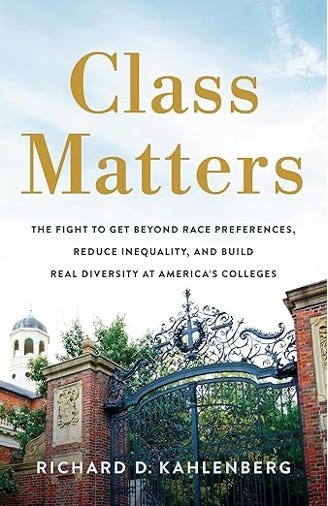Tl;dr – An excellent read – one of the best higher ed books I’ve read in a long time. Kahlenberg makes the strong case that selective universities can create diverse student bodies by ditching race preferences and instead enacting policies of affirmative action for socioeconomically disadvantaged students, with the added benefit of increased class diversity. Of course, universities don’t want this because it actually costs money to educate poor students.
In 2023, the U.S. Supreme Court ruled to end race-based affirmative action in college admissions. This came as a big shock wave to universities whose admissions policies had boosted acceptance probability for black and hispanic students at our nation’s most selective colleges for decades in an effort to create a “diverse” student body – across the single dimension of skin color.
What I didn’t know when this occurred, is that this is a fight that was a long one. In Class Matters: The Fight to Get Beyond Race Preferences, Reduce Inequality, and Build Real Diversity At America’s Colleges, Richard D. Kahlenberg details the history of race preferences – and his role in the long fight to end them in college admissions.
With the rise of race-centric politics in the 2010s, college admissions at selective institutions came under particular scrutiny as students – largely white and Asian students – claimed discrimination at the hands of admissions officers because their skin was the wrong color. Students of black or Hispanic background were shown to gain significant advantages in admissions in the efforts of institutions to create student populations that reflected the look of America.
While a superficially noble goal, America’s diversity comes from more than the color of one’s skin. And a small but persistent minority knew that. For decades proponents of affirmative action based on socioeconomic class as a better alternative kept losing the battle at the very end. Universities lobbied hard to keep race preferences and claimed that class-based affirmative action simply wouldn’t work as well. But it wasn’t that it wouldn’t work to create diversity. It wouldn’t work because poor kids are more expensive than rich minority kids to educate.
Rather than actually striving for a student population that reflected America on not only skin color, but also socioeconomic status which correlates to political and familial educational diversity, college admissions officers knew they could game the system by admitting rich minority students to give the appearance of diversity, without the literal cost.
But finally, in 2023, SCOTUS required that race-based affirmative action be ended. Now colleges needed to use the methods that several of the largest states, including Texas, Florida, and Washington, had been doing effectively for years: find class-based ways to build diversity, increase admissions of first-generation students and those from lower socioeconomic standing.
The exemplar of alternative strategies is Texas’ 10 percent plan which automatically grants any student in the top 10 percent of their high school class admission to the UT system. Now students who are in the worst schools without all the advantages money can buy still have a door to opportunity via higher education. The plan, in place since 1997, has proven effective in producing a student body that reflects its population, and high performing, but financially strained students, perform well academically. It’s a win-win.
Richard D. Kahlenberg was a key player in this long battle. He was in the court rooms, and although he found himself in “uncomfortable company” as a liberal siding largely with conservatives on this issue in today’s culture, he stuck to his principles and helped ensure that students without the means to pay their way had better access to the top institutions in our country. His research showed how places like Harvard and UNC would flat out lie about the ability of class-based affirmative action being able to work. His simulations on their admissions data proved otherwise.
As always with elite institutions, it all comes down to money and the institution’s ability to game the system to boost its rankings. It’s similar, in my opinion, to the facade of elite institutions going test-optional long after Covid closures required it: students with low scores were less likely to submit them, making the institution’s average SAT score higher which helped out their US rankings. Their goals have nothing to do with students and everything to do with metrics and money. I swear admissions is sucking the soul out of higher ed.
But this was a fantastic book. Kahlenberg expertly and persuasively makes the case to ditch race preferences, embrace class preferences, and bring more diverse types of diversity to our nation’s elite colleges. I think he’s clearly right. It’s a book that should be on everyone’s TBR who cares about higher education.
Reader poll
Published: March 2025
Publisher: PublicAffairs
Format: Harcover
If you think this sounds interesting, bookmark these other great reads:
Breaking Ranks: How The Rankings Industry Rules Higher Education and What To Do About It (2022) Colin Diver | Read my review
The End of Race Politics: Arguments for a Colorblind America (2024) by Coleman Hughes | Read my review







To the ivory towers: We not knocking. We replanting the roots, restocking. You forgot the dirt that gave you breath — but we remembered. And now we step.https://open.substack.com/pub/thehiddenclinic/p/to-the-ivory-towers-that-forgot-the?r=5hogqp&utm_campaign=post&utm_medium=web&showWelcomeOnShare=true
Sounds like a fascinating book. Definitely going on my TBR list.
Tangential question: does the author mention the mismatch hypothesis as an argument against race based preferences?
I was having a friendly debate with someone recently about that.